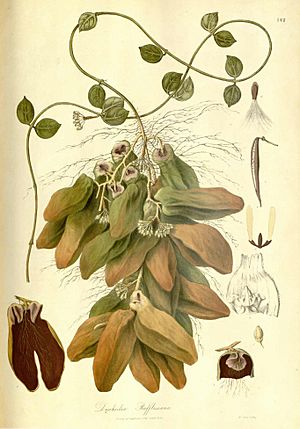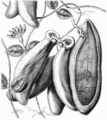Malayan urn vine facts for kids
Quick facts for kids Malayan urn vine |
|
|---|---|
 |
|
| Plate 142 from Plantae Asiaticae Rariores | |
| Scientific classification | |
| Genus: |
Dischidia
|
| Species: |
major
|
Dischidia major, also known as the Malayan urn vine, is a very special plant. It's a type of plant that grows on other plants, like trees, but doesn't harm them. These plants are called epiphytes. You can find them in warm, tropical parts of Asia and the western Pacific.
Contents
The Malayan Urn Vine: A Unique Plant
Dischidia major is part of a group of plants called Dischidia. There are about 80 different kinds of Dischidia plants. They often trail, twine, or climb. They are also succulent, meaning they have thick, fleshy parts that store water. You can find them across tropical Asia, including places like New Guinea, the Moluccas, the Philippines, India, and tropical Australia.
A Home for Ants
One of the most amazing things about Dischidia major is how it works with ants. These plants have special leaves that act like tiny homes for ants. This helpful relationship, where both the plant and the ants benefit, is called mutualism. When plants have this special bond with ants, it's known as myrmecophily.
Why Ants Help
The ants get a safe place to live inside the plant's leaves. In return, the plant gets good things from the ants. For example, the ants' waste can give the plant extra carbon dioxide and nitrogen, which are like food for the plant. The ants also help protect the plant from animals or other plants that might try to harm it. This teamwork is very common in the plant world and is super helpful for both the ants and the plant.
How It Gets Food
Dischidia major likes to grow around the branches and trunks of trees, especially older, decaying ones. It grows two different kinds of leaves:
- Small, round, succulent leaves that are about 2 centimeters wide.
- Hollow, pouch-like leaves that can be up to 12 centimeters long. These look a bit like small bags or pitchers.
The Pitcher Leaves
These special pitcher leaves are often purplish. Inside, they have many tiny holes called stomata. There's an opening at the top of the leaf, near its stem. Over time, rainwater and bits of leaves or other natural debris collect inside these hollow leaves. The plant then grows roots right into this chamber. These roots soak up the nutrients from the collected water and debris, helping the plant to grow. Some other Dischidia plants, like Dischidia astephana and D. parvifolia, don't house ants. Instead, their roots grow into decaying wood and ant nests to get nutrients from ant waste.
Flowers and Reproduction
The flowers of Dischidia major are yellow with green stripes. They grow in groups called umbels. After the flowers, the plant produces fruit.
Spreading Seeds
The fruit of Dischidia major looks like two horn-shaped pods. Inside these pods are the seeds. Each seed has a fluffy tuft of silky hairs at one end. It also has a small, tasty part called an elaiosome. This tasty bit is a treat for ants! The ants pick up the seeds to eat the elaiosome, and then they carry the seeds into their nests inside the tree. This helps the seeds to grow in a safe place with good nutrients, giving them a better chance to sprout and grow into new plants. This way of spreading seeds with the help of ants is called myrmecochory.
Images for kids
-
Plate from Richard Wettstein's Handbuch der Systematischen Botanik 1924




